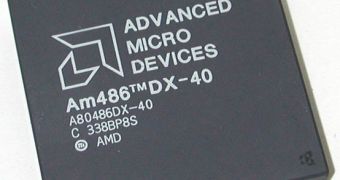The first quarter of 2008 revenue numbers show, according to technology research firm iSuppli, that Advanced Micro Device's announced steady revival has already begun. While its archrival Intel managed to score one point of microprocessor market share over Q4 2007, AMD made it grow by two percent compared to last year's first quarter.
Intel went to 79.7 percent market share in Q1 2008, 1.2 percent more than the 78.5 percent registered in Q4 last year. That looks good only when seen from a certain angle, but the truth is that the company went down from the 80.4 percent share it scored in Q1 2007. Not much of a drop-off, indeed, but the high 70s sound less impressive than the low 80s.
AMD did gain 2.2 percentage on the year-over-year revenue, but that is not entirely due to Intel's loss. The company went from 10.9 percent of global microprocessor market share in Q1 2007 to 13.0 percent this year mainly because other vendors experienced shrinking share. Beside Intel and AMD, some other microprocessor makers owned 7.3 percent market share in Q1 2008, a 1.4 percentage drop from last year Q1's 8.7 percent.
"AMD's PC microprocessor product portfolio has become much stronger during the last year, particularly on the desktop side," said Matthew Wilkins, principal analyst of compute platforms for iSuppli, in a prepared statement. "At the beginning of the year we saw AMD add the quad-core Phenom microprocessors to its desktop portfolio, which it has since built on with tri-core and dual-core flavors," he added.
On the long-term view, AMD seems to be doing quite well, yet iSuppli said that the company should pay attention to the short-term as well. The 1.1 percent market share loss fits 1.2 Intel's gain over the fourth quarter of 2007, and that should be a serious aspect. "Intel was the short-term winner in the first quarter processor market," observed Matthew Wilkins. "But over the previous 12-month period, the trend is reversed, with AMD growing its share."
According to Nathan Brookwood, principal analyst of market watcher Insight64, there are small chances that AMD could regain profitability after a long period of quarterly losses. "Barring an unforeseen disasters, AMD could have a reasonable second half," Brookwood said. "If it is able to increase its share in CPUs and graphics processors it may even be able to move its bottom line from red to black," he added.
Both AMD and Intel expected to release 45nm processors during the next months
On the prices area, the war between AMD and Intel seems to have cooled off, since the report shows that they have been held constant during the first quarter. The next months will show the move each will make in terms of market share. Both companies are getting ready for 45nm products which we are expecting for the second half of the year.
Intel should announce its Nehalem processors at the Intel Developer Forum in San Francisco in August. These are a second generation 45nm CPU's from Intel, and they will come with integrated high-speed interconnect and memory controller, as AMD's Opteron does. The Nehalems will come on single-socket versions for workstations and servers in the beginnings, but dual-socket processors will be shipped by Intel early in 2009. The second half of next year will also bring chips capable of working in four-socket systems.
As for AMD, the company announced for this year the release of Shanghai, its first generation 45nm processors. They are nothing else than a shrink of Barcelona, AMD's 65nm quad-core processors, which experienced a delayed launch due to a design fault. "Sun, HP, Dell and IBM have all refurbished their server lines with new Barcelona systems, so that chip is ramping into volume now," said Brookwood. "If AMD can ship Shanghai this year it will demonstrate its new 45nm process is healthy, and its R&D team is back in terms of execution," he added.
Brookwood also noted that AMD is showing great improvements with its latest graphics and notebook processors. "The latest ATI 4500 graphics chips are probably the strongest competitive parts they have had against Nvidia in some time," he said. While Intel's Montevina notebook platform had some delays getting on the market, AMD managed to release its Puma chip in due time. According to iSuppli, the mobile PC market becomes stronger these days, and notebook shipments are rising, 30 percent in the first quarter of 2008, while the desktop market stays about flat.
AMD CEO Hector Ruiz promised steady sequential revenue during 2008, and also announced profitability starting with the second half of the third quarter. It seems that the company is on the right track, though it experienced some great losses starting with the acquisition of ATI back in 2006. While the $358 million earnings reported by the company in the first quarter are still on the red, the improvement is significant, considering the $611 million lost in Q1 2007. Besides that, AMD lost other $600 million in the second quarter of 2007, not to mention the $1.77 billion loss suffered in Q4, much of it due to an impairment charge on the ATI merger.
"It will be an interesting second half," said Brookwood. "AMD has been trying hard to convince everyone that the dark clouds hanging over them for most of 2007 have blown away."

 14 DAY TRIAL //
14 DAY TRIAL //